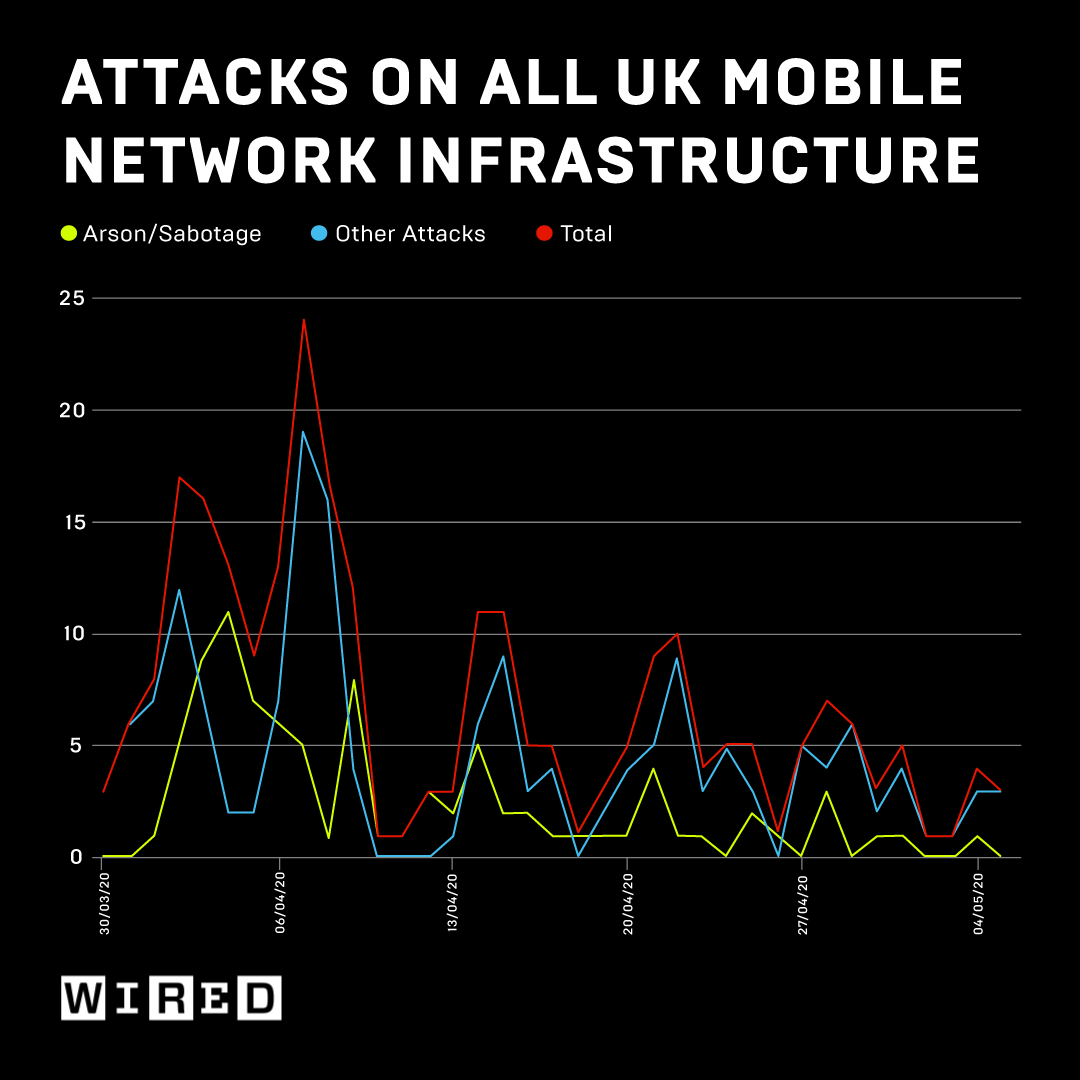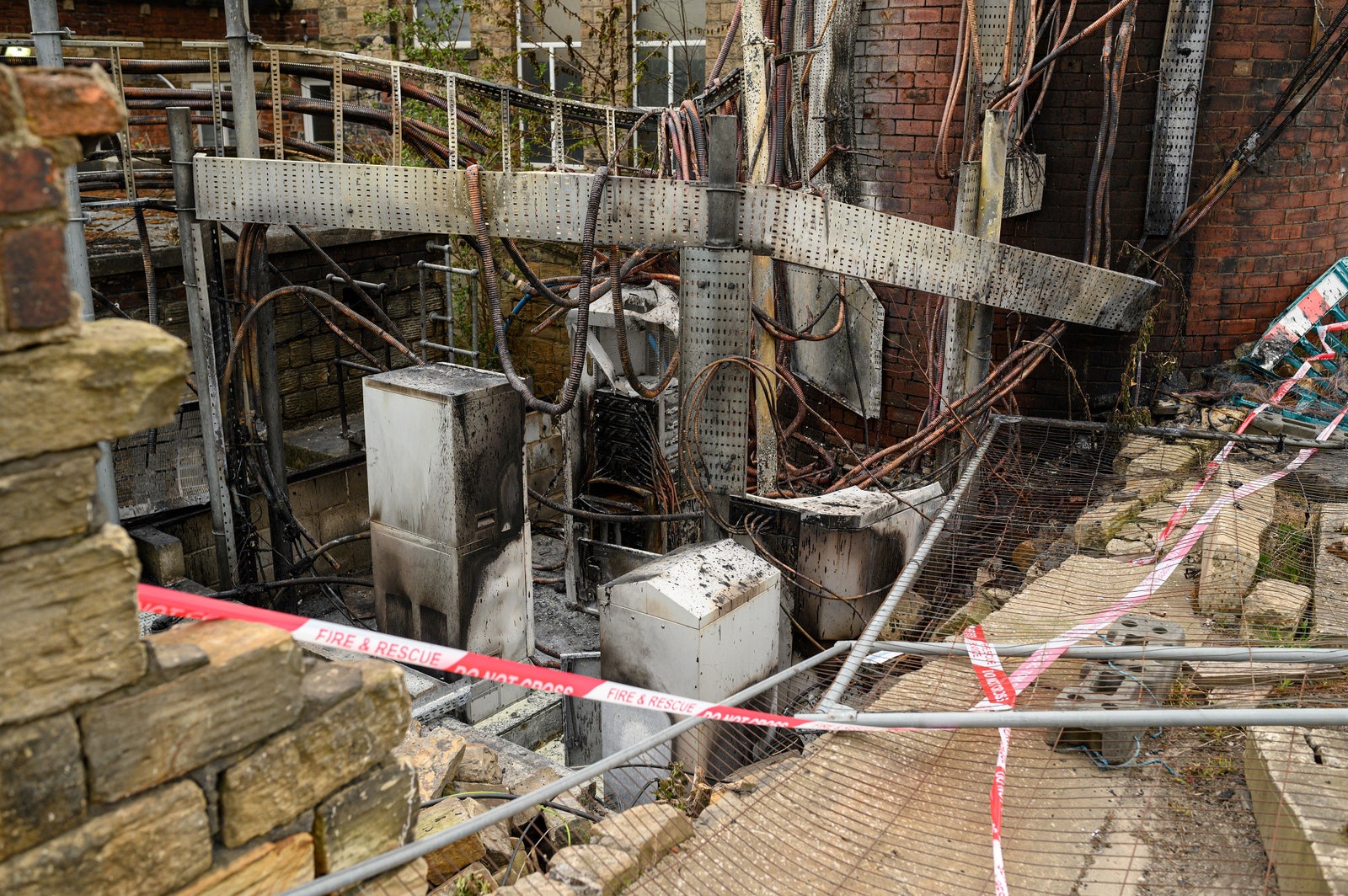The 5G coronavirus conspiracy theory just took a really dark turn
Mobile phone masts in the UK are still being attacked by arsonists on a daily basis because of a conspiracy theory linking 5G to the spread of coronavirus. New data seen by WIRED reveals that dozens of attacks have taken place in the last fortnight, with conspiracy theorists targeting both infrastructure and key workers in the misguided belief that they are somehow spreading coronavirus. In one incident, a broadband engineer was spat at in the face by an enraged member of the public. The engineer is now ill with suspected coronavirus.
Since March 30, there have been 77 arson attacks on mobile phone masts across the UK, with staff working on mobile infrastructure also reporting 180 incidents of abuse. There have been 13 additional incidents of sabotage reported, ranging from failed arson attacks to attempts to damage mobile network infrastructure in other ways. From April 20 through May 5, more than a week after the supposed peak of attacks in early April, there were 16 arson or sabotage attacks on mobile phone masts. When failed or attempted attacks are added to the tally, that number increases to 74.
The figures from the mobile phone sector are mirrored by Openreach, which is responsible for maintaining much of the UK’s broadband infrastructure. The company has recorded 63 incidents of abuse directed towards its staff while out working since April 1, with conspiracy theorists often filming such encounters while shouting and swearing at terrified key workers. Footage of these confrontations is then shared on social media. In the last two weeks of April, Openreach recorded 20 incidents of this nature.
The conspiracy theory linking 5G to coronavirus has spread rapidly through Facebook and YouTube in recent weeks. It was given further prominence when a number of celebrities – including TV star Amanda Holden, Hollywood actor Woody Harrelson, and boxer Amir Khan – shared it on social media. Despite social networks pledging to take more concerted action against it, the conspiracy theory has continued to spread in recent weeks.
The online spread of the conspiracy theory is still having dangerous real-world consequences. Openreach engineers, none of whom are even involved in installing 5G infrastructure, have been exposed to a barrage of abuse. One person threatened to throw a brick at an Openreach engineer’s head, returning several minutes later shouting and wielding a bottle. In another incident, an engineer was told they would be in “fucking trouble” if it turned out they were installing 5G, with the abuser then punching their van door and walking off. Elsewhere, a woman shouted that 5G was “more dangerous than Covid-19”, called an Openreach engineer “fucking mental” and said she would get her brother and six friends over to “do him in”.
While angry shouting and threats typify many of these incidents, some have resulted in physical acts of violence. Michael, an apprentice network engineer working for Openreach in London, was spat at in the face by an angry member of the public. Michael has since had to self-isolate after becoming ill with suspected coronavirus. He was too unwell to be interviewed for this story. Another Openreach engineer has been stabbed and put in hospital.
Dylan, an engineer working for Openreach in Leicester, who was verbally abused while driving his van, describes the incident as “quite intimidating”. In Dylan’s case, a man got out of his car while at a red light on a dual carriageway and started shouting abuse and banging on his van.
“He put his head against my window, he’s saying, ‘Don’t you ignore me, stop trying to cover up what you’re doing, 5G is killing us all, you’ve got no morals’,” Dylan says. “You’ve got someone right there and you’re on your own. You wonder if he’s going to smash the window, what’s he going to do if he does get in, is he going to attack me? I seized up and just waited for the light to go green.” While this was happening, another individual remained in the parked car and filmed everything. Dylan says the incident has left him shaken. “When I’m on my own I feel a bit cautious, a bit on edge. And I can’t fully focus on the task at hand because I’m always keeping an eye on what’s happening.”
Tiffany, another Openreach engineer, experienced similar intimidation from a member of the public who went on a “power trip”, lecturing her about the apparent dangers of 5G while she was trying to fix broadband infrastructure on a residential street. “He was saying, ‘I’m a reporter, I’m going to be putting this everywhere’. He was going to put out this thing saying I was spreading coronavirus when I was just doing my job. I felt really vulnerable while it was happening and really intimidated by him. I was shaking all day after.” Tiffany later found the video on Facebook and YouTube, though it has since been removed.
The continued abuse of key workers and attacks on critical infrastructure hint at how widely this conspiracy theory continues to circulate online. In the last seven days alone, more than 54,000 posts referencing 5G and coronavirus have appeared on Facebook, generating over two million interactions. The most popular of these posts – featuring an image of Bill Gates with devil horns, has received more than 4,600 shares, comments and interactions. Two posts protesting the removal of conspiracy theorist David Icke’s Facebook page have together generated more than 7,000 shares, comments and other interactions.
The response from social networks has been spasmodic at best. While figures such as Icke have been banned, other Facebook groups with huge followings that peddle similar conspiracy theories are still active. Earlier this week, Twitter introduced a feature that prompts people posting about the conspiracy theory to read fact-checked advice. At the same time, David Icke’s Twitter profile is still active. On YouTube, conspiracy theory videos revealing “the truth” about 5G and coronavirus are still getting tens of thousands of views.
The worry for industry figures is that despite a widespread and concerted effort to debunk the dangerous 5G coronavirus conspiracy theory, it continues to thrive both online and in the real world. “It’s deeply frustrating and saddening that our engineers are facing abuse of this kind,” says Catherine Colloms, managing director of corporate affairs and brand at Openreach. “We’ve seen a worrying surge in incidents where our engineers are being subjected to mindless verbal abuse or intimidation linked to the bogus 5G theory. It really needs to stop.”
James Temperton is WIRED’s digital editor. He tweets from @jtemperton
Updated 07.05.20, 16:20 BST: There have been 13 sabotage attacks and 77 arson attacks on phone masts in the UK. An earlier version of this story incorrectly stated there had been 90 sabotage attacks and 77 arson attacks.
😓 How did coronavirus start and what happens next?
❓ The UK’s job retention furlough scheme, explained
💲 Can Universal Basic Income help fight coronavirus?
🎲 Best video and board games for self-isolating couples
👉 Follow WIRED on Twitter, Instagram, Facebook and LinkedIn
This article was originally published by WIRED UK





